N° 1
January 2021
—
TTS Italia is the Italian ITS Association founded with the aim to promote the development and deployment of Intelligent Transport Systems (ITS) in Italy.
|
|
|
|
|
|
|
The European strategy: ITS and green in the (near) transport future. Here are the actions for the smart mobility by 2022

Europe must fully exploit the benefits of digital solutions and intelligent transport systems (ITS). This sentence represents the heart of the European mobility strategy of the (near) future. In fact, the EU Commission presented on 9 December its ‘Sustainable and Smart Mobility Strategy', the action plan for smart and sustainable mobility based on three fundamental principles: sustainability, process digitization and system resilience. Eighty-two initiatives grouped into 10 main actions (flagship), each declined in concrete initiatives to be implemented over the next two years (2021-2022) to reach the medium and long-term objectives described by the plan in line with the final purpose of the Green Deal: a 90% reduction in emissions by 2050, achieved through an intelligent, competitive, safe, accessible and affordable transport system.
The European strategy
In this plan, technology and digital are the connecting element between the sustainability and resilience of the system, a fundamental component at the basis of the new configuration of transport in Europe which foresees at least 30 million zero-emission cars on the roads by 2030 , 100 climate-neutral cities, the doubling of high-speed rail traffic, collective journeys planned for routes of less than 500 km neutral in terms of carbon emissions, the large-scale deployment of automated mobility and zero-emission ships. By 2035, however, the use of zero-emission aircraft is expected and finally, by 2050 almost all vehicles (including heavy vehicles) will be zero-emission, rail freight traffic will have to double and the trans-European multimodal transport network (TEN-T) will be fully operational for sustainable and intelligent transport with high-speed connectivity. In short, a broad strategy outlined in 111 points with a basic awareness: the crisis due to the health emergency for Covid-19 must be used as an accelerator for the decarbonisation and modernization of the European transport system. The European Commission will put in place suitable measures to translate the plan into reality, but operators are also called upon to do their part to guide the transition on the two pillars of the plan.
Smart mobility
A chapter with two “flagships”: connected and multimodal mobility; innovation and artificial intelligence for smarter mobility. Central to the use of ITS, the Commission wants to implement actions that can direct research towards CCAM (connected, cooperative and automated mobility) through partnerships envisaged with Horizon Europe or with other tools to bridge not only technological but also regulatory gaps in view of the increasingly massive use of automated vehicles. An aid in this sense is the establishment of an agency (or other institution) to support the development and use of ITS and connected mobility in Europe provided for in the document. An important step is the dematerialization of travel documents which must also be multimodal (both for passengers and goods) throughout Europe. Finally, actions are planned to avoid capacity crises in traffic management and revision of the Technical Specifications of Interoperability for the most important technologies such as 5G and ERTMS for rail transport. Innovation is the watchword of the second pillar: here Europe aims to create a comfort zone for experimenting with new technologies and start-ups: drones, hyperloops, hydrogen planes, electric personal planes, innovative vehicles for water transport which will be able to find various sources of financing in European funds.
5G and artificial intelligence are the technologies to focus on, while the exchange of data is seen as a problem to be solved through the establishment of a European Common Mobility Data Space, i.e. a safe environment, in particular for operators, where to share information and data. The time target is 2030: by this date, the travel of people and goods in Europe will have to be multimodal and paperless, while automated mobility will have to be applied on a large scale.
Sustainability and resilience
All modes of transport must strive towards the goal of zero emissions: for vehicles, ships and airplanes the possibility of using renewable and low-emission fuels with related recharging infrastructures. Even airports and ports must invest in green to make their systems sustainable. An entire chapter is dedicated to the sustainability of logistics. More freight by sea and rail, low-emission vehicles and multimodal systems. The actions planned for the mobility of people focus on high-speed rail traffic. The expansion of the use of bicycles in urban areas is also expected, which should double in the next 10 years. The Commission clearly says that the transport sector affects all citizens of the EU and that "no one will be left behind" in this great progress that will have to strengthen the resilience of the system, which has been severely tested by the Covid-19 emergency. Three main actions are aimed at this objective: strengthening the single market, for example by stepping up efforts and investments to complete the trans-European transport network (TEN-T) by 2030 and help the sector to rebuild better through greater investments, both public and private individuals, in the modernization of fleets in all modes of transport. Making mobility fair and just for all, accessible and affordable in all regions and for all passengers, including those with reduced mobility, and making the sector more attractive to workers. Finally, increase the safety of transport in all modes, including bringing the number of victims to zero by 2050.
The European time schedule for the smart mobility: 2021-2022
The European document is accompanied by a time schedule that illustrates the Commission's activity over the next two years aimed at laying the foundations for achieving the objectives. For smart mobility, the following actions are envisaged.
In 2021 the directive on ITS will be revised, including a multimodal ticketing initiative, the EU legal framework on the approval of automated vehicles completed, adopted an implementing legislation for the approval of connected and automated vehicles, related measures proposed for electronic documents for internal crew and ships, developed (or renewed) research partnerships on connected, cooperative and automated mobility, Shift2Rail, Sesar, partnerships for clean hydrogen, smart networks and services, AI, data and robotics and digital technologies. Also planned for this year is the development of a common European data space on mobility and the establishment of a stronger coordination mechanism for the national access points established by the ITS directive, a roadmap on artificial intelligence in mobility, the revision current EU type-approval legislation to facilitate data-based services from cars.
Between 2021 and 2022 the revision of the Delegated Regulation 2015/962 on real-time traffic information services is planned to extend geographic coverage and data series, as well as the Revision of Delegated Regulation 2017/1926 on Multimodal Travel Information Services to include mandatory accessibility of new dynamic datasets and further development of the regulatory framework for drones and unmanned aircraft, including U-Space, adopting the drone strategy 2.0.
In 2022 the need for regulatory action on the rights and obligations of multimodal digital service providers will be assessed and a recommendation issued to ensure that public service contracts do not hinder data sharing and support the development of multimodal ticketing services, together with a initiative on ticketing, including rail ticketing. An agency or other body is also planned to support safe, smart and sustainable road transport operations. The adoption of railway technical standards and the package of specifications on ERTMS control-command and signaling (CCS) is in the agenda too; as well as the development of mandatory deployment plans for automatic train operation and automated traffic management. Finally, the establishment of a high-level group (New Mobility Tech Group) as a first step towards developing a coherent EU approach and a set of recommendations to facilitate the experimentation of emerging mobility technologies and solutions in the EU are included. |
|
|
|
|
|
|
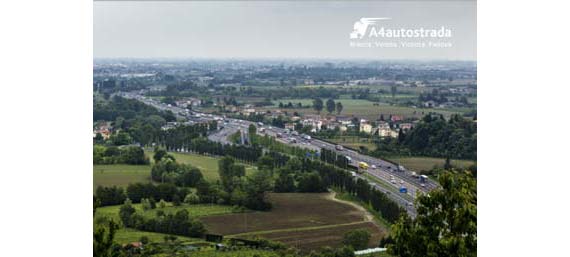
Autostrada Brescia-Padova/A4 Holding Group
Autostrada Brescia Verona Vicenza Padova Spa is part of the A4 Holding Group which, in turn, is held by the Spanish Abertis Group, a world leader in the management of toll rolls, serving 8,600 km and operating in 16 countries throughout Europe, Asia and the Americas.
The company manages the motorway networks of A4 Brescia-Padova and A31 Valdastico under concession, for a total of 235 km of motorways and 60 km of ring roads.
Autostrada Brescia Verona Vicenza Padova has been operating for 68 years and was created to connect the east and west of the Po Valley, to allow the economic and industrial development of the four provincial areas it passes through (Brescia, Verona, Vicenza and Padova).
Today, the company supports projects to improve the road system and make it more efficient, by designing, building, and managing new infrastructures, and developing technologically innovative solutions for the best quality of services and passenger safety.
—
PRODUCT IN THE SPOTLIGHT
Innovation Garage the project to develop more innovative, safer and eco-friendly motorways
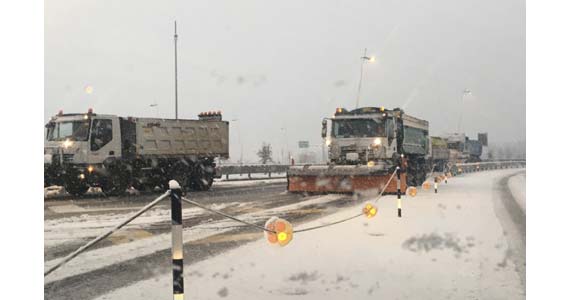
Innovation Garage held by the Abertis Group, world leader in motorway management. This project aims to bring about innovative ideas to improve road and infrastructure management, using the most advanced technologies, together with other companies belonging to the Group in the various countries where Abertis is present. To this aim, a three-year partnership has recently been signed with the information technology giant IBM, which aims to jointly develop a number of projects on the mobility of the future.
Autostrada Brescia Verona Vicenza Padova is at the head of two multidisciplinary working groups that are preparing two projects in the areas of Physical Infrastructures and Mobility. More specifically, we are working on a programme that aims to develop a continuous monitoring system of asphalt, thanks to the intervention of software equipped with artificial intelligence, in order to prevent the degradation of the pavement and therefore ensure precise and timely maintenance.
The second initiative involves the creation of a system to optimise winter operations, so as to minimise their impact both on the environment and on traffic, while maintaining the main objective of further raising the level of road safety for drivers. Through the use of cutting-edge technologies, such as the analysis and processing of big data and the Internet of Things, the aim is to achieve the most accurate forecasting possible of how winter operations on motorways will be managed, in response to snowfall forecasts, also to minimise the impact of snow and ice melting agents, such as salt.
—
TWO QUESTIONS TO
Gonzalo Alcalde - President of Autostrada Brescia Verona Vicenza Padova
 The A4 motorway from Brescia to Padua has always been a strategic road link for northern Italy and beyond. However, on the A31 traffic is becoming increasingly heavier, whilst also becoming an indispensable link for the Veneto and Trentino highlands. What investments do you have planned, and which projects will have the greatest impact on the routes managed by you? The A4 motorway from Brescia to Padua has always been a strategic road link for northern Italy and beyond. However, on the A31 traffic is becoming increasingly heavier, whilst also becoming an indispensable link for the Veneto and Trentino highlands. What investments do you have planned, and which projects will have the greatest impact on the routes managed by you?
In recent years, Autostrada Brescia Verona Vicenza Padova has further strengthened the trend of its investments in the routes it is responsible for, so as to benefit strategic interventions on the infrastructure, with an aim to making the route from Brescia to Padua and the whole of the A31 Valdastico two of the most fluid, modern and safe road links in Italy. In our economic and financial plan, we have allocated over 4 billion euros of investments for ordinary and extraordinary maintenance, minor works, and also complicated interventions, in order to improve those strategic links for tourism, economy and development in the Veneto region. Specifically, we have two projects worth over 200 million euros, aimed at improving the link between the motorway A4 and the Lower Garda area of the Province of Verona (the construction of a new toll booth in Castelnuovo del Garda) and to facilitate the best road conditions for the link with the Superstrada Pedemontana Veneta (completion works of a new toll booth in Montecchio Maggiore). However, that is not all, as together with the Municipality of Verona, we recently drew up a comprehensive and innovative project, divided into works interventions and road systems planned for the next six years. These will be carried out to support the development of Verona’s southern quarter, which has always been a commercial, trade fair and logistic hub of primary importance, both for the city’s economy and that of the Veneto region. This is an investment totalling more than 80 million euros, that will improve accessibility to the motorway, ring roads, bus terminals and the city, with the utmost collaboration with local institutions, therefore reinvesting in the growth of the area. Our particular attention is further dedicated to the development and interconnection of the whole North East. The project for the extension of the A31 Valdastico to the North, between Veneto and Trentino Alto Adige, is a strategic move for A4 Holding for the road system, infrastructure and economic development in Veneto and the North East. The definitive 18 km project for the Veneto route from Piovene Rocchette to the Astico Valley has recently been completed, after an extremely complex three-year process. This investment is fully borne by the highway authority of A4 Holding Group (Autostrada Brescia Verona Vicenza Padova SpA) and amounts to 1.3 billion euros just for the first lot to be built in the Veneto region alone. This is to extend the existing 90 km arterial road north, that already runs from the province of Rovigo to Vicenza, in the hope that all technical and administrative requirements can be determined as soon as possible for the subsequent planning and building of the second lot, therefore completing the corridor of interconnection with the Valsugana and Adige Valley in Trentino.
How is the infrastructural system of the North East as a whole being redesigned, and how can the best collaboration with other motorway network authorities be obtained, in order to ensure the most sustainable and safe development of the road network?
The motorway concessionaires have made numerous investments to design and implement a more modern road system in the North East. Along the A4, for example, in addition to our major interventions in the provinces of Vicenza and Verona, the construction of a third lane on the Venezia-Trieste is nearing completion.
The beginning of high-speed railway construction sites between Brescia and Verona, the port and logistics development projects in Veneto and Friuli Venezia Giulia, and the new guidelines set out in the Veneto Region's Regional Transport Plan are all essential factors that enable us concessionaires to read and interpret what the policies and plans for the development of the mobility of people and goods in the coming years will be.
A4 Holding has always been an active partner, collaborating with other motorway operators and local institutions, to actively promote projects and interventions useful for the completion of an infrastructural design connecting the North East of Italy to Europe.
In order to be able to take on the most ambitious challenges, continuing and promoting a path of growth in a changing socio-economic framework, it is therefore necessary to further develop collaboration between the different operators of the ports, airports, road and rail infrastructures in the North East of Italy.
On our side, we have strengthened our relationship with the CAV - Concessioni Autostradali Venete, and Autovie Venete (two concessionaires that manage motorways in the Veneto and Friuli Venezia Giulia regions), increasingly encouraging a daily exchange of information useful for the best possible running of the adjacent routes under management, also with the aim of developing new projects together, linked to the technological evolution of roads (ITS projects), and enhancing customer service. |
|
|
|
|
|
|
Autoroute: your turnkey solution for school bus service management

Autoroute is a new joiner of TTS Italia, which provides integrated technological solutions for transportation companies and public administrations, with more than 10-year experience in school bus transportation service.
Autoroute has implemented its digital platform for e2e school bus service management in 2012 and constantly keeps it up to date thanks to quarterly updates.
Among its features, Autoroute® 4.0, provides for:
— Dematerialization of service requests, thanks to customizable digital forms and workflows that support backoffice activities
— Automatic load of master data based on approved service requests, i.e.:
o Schoolchildren
o Parents
o Stops
o Schools
— Automatic service planning based on actual mobility demand:
o Lines and routes design
o Detailed scheduling for each schoolchild
— BLE or NFC tags association to schoolchildren to enable automatic recognition of ‘’waiting’’, ‘’onboard’’ and ‘’arrived’’ status.
— Association of vehicles to bus lines and specific trips, which can be made by both operations room and the bus drivers themselves, thanks to the ‘’smart driver unit’’.
— Real time service monitoring
— Integrated internal and external reporting
— Service certification tool
Furthermore, thanks to the smart ‘’smart driver unit’’, each driver can view the trips he has been assigned and start the service. Integrated satellite navigation helps the driver reach each stop on time and thanks to smart digital buttons, the driver can easily notify the operations room about emergencies, damages or route deviations.
Moreover, thanks to the mobile app ScuolAPP® (ScuolAPP.eu), each family can real time monitor the bus location and check whether their children are onboard. The communication towards end user is made easier thanks to automatic push notifications.
ScuolAPP® enables also easier communication from families to the bus service manager; in fact, each parent can easily cancel a trip and this is atomically notified to the operations room, which can adjust transportation planning based on actual mobility demand.
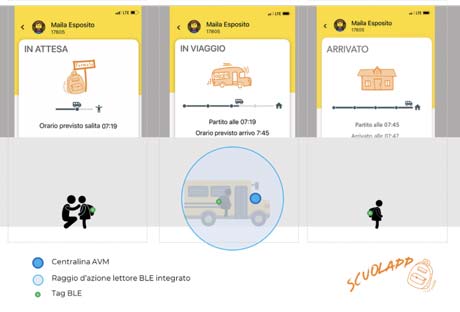
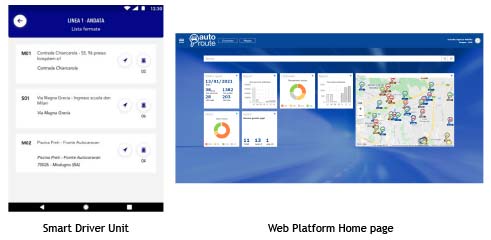
|
Latest release delivers immersive 3D imagery and experiences

Hexagon’s Geospatial division has launched Luciad 2020.1, a significant update to its platform for building advanced location intelligence and real-time, situational awareness applications. Luciad 2020.1 delivers immersive 3D experiences with 360° panoramic imagery support that can be combined with other 3D data layers, a unique capability in the geospatial application market. The latest release also features additional styling for 3D meshes and 3D data integration capabilities.
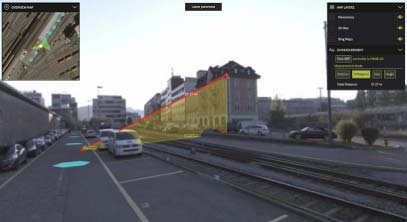
Hexagon’s Luciad portfolio allows developers to create powerful, high-performance applications that leverage data from any source for visualization and analysis in 2D and 3D. Combining static, dynamic and real-time data, including moving tracks, Luciad-powered applications support defense, aviation, infrastructure and other critical sectors.
For the 2020.1 release of LuciadRIA, which is used for building browser-based solutions, Hexagon has added 360° panoramic imagery capabilities which can be combined with other 3D data layers to provide complete imagery coverage and detailed information about a location. This capability is the only one of its kind on the market. Panoramic imagery puts users in control of what they want to look at within an image. The panoramic 3D experience is powered by a new streaming imagery data service in LuciadFusion, Hexagon’s OGC-compliant server solution.
“With the addition of panoramic imagery capabilities and other 3D data enhancements, Luciad 2020.1 puts local governments, transportation departments, utility companies and others in control of what they can observe and analyze within a particular scene,” said Mladen Stojic, president of Hexagon's Geospatial division. “With these capabilities, organizations can remotely monitor their assets and infrastructure, significantly reduce manual inspection processes and fully leverage location intelligence across the enterprise.”
The release contains other new features and improvements requested by customers, including military grid coordinate transformations, non-georeferenced WebGL-based views, improved imagery sampling and additional format support and upgrades. For defense customers, the Luciad 2020.1 release consolidates its market-leading military symbology support to be pixel perfect across all Luciad platforms and programming languages.
To learn more about Luciad 2020.1, visit https://www.hexagongeospatial.com/ |
|
|
|
|
|
|
Fondazione Cortina 2021 and AlmavivA launch a digital system for safe and smart mobility

Digital innovation at the service of top level sports and fans for mobility worthy of champions on the track and on the road. Fondazione Cortina 2021 and AlmavivA launch an integrated and entirely digital system that will allow a smart, safe and more sustainable mountain experience.

AlmavivA, Technical Partner of Cortina 2021, brings the “Moova Mobility Service Center” to the Alpine skiing world championship. The Italian Information Technology company, a leader in the transport and Digital Transformation sector, will provide a “Situation Room” for the event scheduled to take place in Cortina d’Ampezzo from 7 through 21 February 2021. The room has been custom designed to facilitate mobility in the territory, enhancing the synergy between all the players involved. The system, set up in the Foundation’s spaces, will allow Cortina 2021 to view the integrated data on mobility provided by Veneto road and infrastructure operators, as well as open data, in a single solution.
Safety, sustainability and logistics are the keys to a successful event. From a Smart Road and Smart City standpoint, the features of the Situation Room allow real-time monitoring of road conditions, video surveillance in critical points for traffic management, abnormal events associated with mobility (e.g. Accidents, traffic, atmospheric events), updates on the weather, available parking, medical and anti-Covid facilities, distributors and the location of shuttles, also integrated by information and services related to the primary places of interest. The infomobility section of the Cortina 2021 App will also provide the general public with real-time updates using a dynamic map.
After the World Championships, this experience will serve as a base for the development of further forms of smart transportation and integrated services for sustainable mobility to benefit residents and tourists, in complete harmony with the Cortina 2021 mission of creating a lasting legacy for the community and the territory.
“What we are presenting today is a small, large revolution for the mountain tourism experience that will let us rethink, plan and organize mobility on a local level, minimizing traffic on the road and streamlining travel between different areas of our town from a standpoint of greater sustainability”, stated Valerio Giacobbi, Managing Director of Fondazione Cortina 2021. “Once again, the World Championships are proving to be a fundamental driver of development and transformation to rethink practices and systems, helping us find innovative solutions to combine the development of tourism in the Queen of the Dolomites with the essential attention to an extraordinary territory, part of the UNESCO World Heritage Dolomites.”
“Quality of performance, strong focus on results and constant commitment are goals that guide AlmavivA’s operations and which are at the base of every sport in its highest expression”, commented Smeraldo Fiorentini, Transportation General Director for AlmavivA. “We are pleased to be a partner of Cortina 2021 and to bring our contribution of digital innovation with the integrated Moova mobility platform to this globally relevant event rooted in the Veneto territory, where we have collaborated for some time. Working alongside companies and public administrations in a digital transformation that brings value is our mission. We are able to do this because of our skills, experience and ‘Made in Italy’ know-how, using the most advanced technologies.”
|
OpenMove starts the pilot of an integrated intermodal tariff system between the different transport modes on the Venice - Verona axis, from a MaaS and Account Based Ticketing perspective

Starting from December 2020, OpenMove has been entrusted by the Veneto Region with the "Experimentation service of an integrated intermodal tariff system between various forms of transport on the Venice - Verona axis” for a duration of 12 months.
The aim of the experimentation is to verify the effectiveness of unified travel tickets and procedures, including innovative ones, for their management, as well as the related effects on both users and the stakeholders involved.
The field of application of the experimentation is the Verona - Venice axis, adopting as a case study the hypothetical journeyunified travel tickets by a user moving from the suburbs of Venice to the suburbs of Verona (for example, from a location on the Venetian coast to Lake Garda).
The service provides for the definition - in collaboration with the Public Authorities, transport service providers and managers of shared mobility systems (car sharing and bike sharing) of the areas involved - of modular and progressive digital travel tickets, with integrated tariffs between the different operators, which allow, for the execution of a trip, the usage of multiple public transport services in an integrated and seamless form, both in the "transport chain" and in the procedures for purchasing the travel tickets. In particular, the operators currently involved in the MaaS system are:
- ATV, public transport operator of Verona
- Clear Channel, bike sharing operator in Verona
- Trenitalia, operator of the national railway transport service
- AVM, public transport operator of Venice
- Mobike, operator of bike sharing in Venice
The use of the aforementioned transport services is provided through a dedicated app, which allows the user to flexibly plan - even after the journey has begun - between multiple combinations of routes and means of transport and the purchase of travel. OpenMove sets up its own software suite for the realization of:
- a MaaS Integration platform that allows the integration of the various transport services. The platform allows access to reporting and clearing capabilities between the transport operators involved;
- a layer of MaaS Operation, that is an interface dedicated to final users to be able to travel in a completely dematerialized way. Thanks to the app, the users will have a single environment available for infomobility - with an integrated trip planner function - and payment of a unified regional travel ticket (from Venice to Verona) and other best-fare tickets. Activations will be carried out by users themselves, with access to transport services (bus, train, bike) by framing the QR Code or by self-activation of the digital ticket.
The data will be available via API in order to favor the production of a specific database that allows the archiving, extrapolation and processing of data for transport analyses aimed at optimizing the services provided, in harmony with the current Regional Transport Plan of the Veneto Region. The assignment will be carried out in coordination and consistency with the assignment entrusted to the company Nemo, entitled "Study service for the definition of an integrated intermodal tariff system between the different forms of transport on the Venice-Verona axis" and related to the tariff scheme.
|
Back to School: the solution by myCicero for a safe and reliable school transport
A complete solution to meet the mobility needs of students
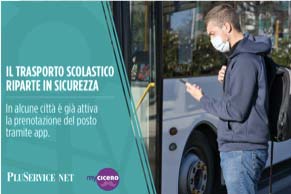
The period of health emergency connected to the SARS-CoV-2 pandemic has led to the need of adopting important stringent regulations that have affected the education system, and inevitably the public transport sector.
Considering the evolution of the epidemiological situation, on 22 December 2020 the "Operational Document" was approved for joining up forces with the educational institutions and local public transport operators in order to implement the provisions of the DPCM [ndr Decree of the President of the Council of Ministers] of 3 December 2020. This latter provides for the measures to be taken for matching the entry-exit times of students from secondary schools with the timetables and the needs of local public transport companies. This will help to start again, in safe conditions, the teaching activities in presence for 75% of the student population, as of past January 7, 2021.
With predictable delays, the Italian Regions are deciding to open again the schools with no particular order, but with the deadline set for 1 February 2021, also in order to allow for an in-depth and differentiated analysis in the various territorial contexts.
The return to face-to-face lessons is an important achievement in terms of the right to study for more than 2.5 million high school students*, who will be added to the students of the other types and levels of education: a figure that provides an idea of the impact that this huge mass of people who travels every day can have in the current phase of contagion in Italy.
Contrasting the spread of the pandemic and at the same time meeting the mobility needs of students requires certain solutions to mitigate the burden of demand on the transport network and requires a common and coordinated commitment from educational institutions and local public transport companies.
myCicero, thanks to specific skills in the passenger transport sector and a continuous and constant dialogue with operators, offers a complete solution to manage the return to school of millions of students.
Listening, as usual, to the real operational needs of transport operators, myCicero has developed a complete solution that evenly distributes the demand expressed directly by students on the public transport journeys already planned by the companies.
The turnkey solution manages the acquisition of mobility demand from schools and single students, through ad hoc forms and app profiling, in order to know in detail all the mobility needs.
By matching the acquired data with the operator's transport offer, a powerful algorithm evenly distributes the demand on the vehicles in operation, taking into consideration the transport solutions that best meet the mobility needs of each passenger.
After studying the information obtained, the solution provides the transport company with a complete set of data with evidence of the loading level for each trip, any list of unsatisfied users, the assignment of each user to each individual trip. Estimations are also expressed on the further potential demand of the territory.
With the solution proposed by myCicero, transport companies will benefit from numerous advantages deriving from the dialogue with a single comprehensive partner, able to guarantee on one hand to users a safe service and in line with government directives to face the spread of the pandemic, and on the other hand to companies all the necessary information on the demand for mobility in the area.
Two field trials are already running and are receiving great interest from students: the first one with the operator Autoguidovie for booking the extra-urban lines reserved to students of the Pavia area, the second one in collaboration with Atma and the Municipality of Ancona which has provided additional rides of city buses reserved to students with reservation. The rides will take into account the home-school route and the entry and exit times of single travellers. The start of a third field trial is scheduled by the end of January with an extra-urban line by the operator GTT in Turin which will connect the municipalities south of Turin.
These are experiments applied to different territories and different organizations, but identical in substance and objectives: to better adapt the local public transport service with the return to school, guaranteeing the distancing between passengers thanks to the reservation of the seat on board of the bus.
For further information:
https://www.pluservice.net/it/progetti/backtoschool
Giuseppe Mascino
Sales Director
g.mascino@pluservice.net
+39 3486056275
+39 071 799961
* Source INAIL (National Institute for the Prevention of Accidents at Work) and National Health Institute: Technical document on the management of the risk of contagion from Sars-Cov-2 in activities related to the education environment with particular reference to local public transport, December 2020. |
Madrid police cars patrol with mobile Tattile ANPR cameras

Policia Municipal de Madrid has equipped 25 of their police patrol cars with mobile ANPR/ALPR cameras provided by Tattile. Each of the vehicles now carries a modern and equally simple architecture consisting of two ANPR cameras connected to a tablet computer. The information generated by the cameras focusses on photos taken from vehicles and herein the automatic number plate recognition. These number plate data are matched in extremely low latency with specific blacklists in a database.
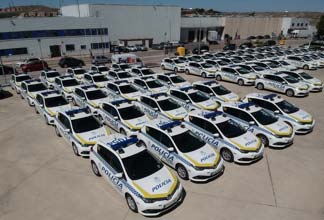
This method using the integrated vehicle plate recognition software allows checking a number plate on several kinds of possible violations such as the absence of vehicle insurance, the absence of a valid technical revision plate, but also crime offences such as stolen vehicles or duplicated number plates.
Thanks to its embedded functionalities (OCR on board, GPS and Access Point Wi-Fi Integrated) and its low power consumption of just 15 W the Tattile ANPR mobile cameras allow quick ANPR camera installation in the police car and movement from one vehicle to another. This makes it the most suitable mobile ANPR police system solution for law enforcement in both in-vehicle installations and for mobile tactical operations.
For contacts:
Fabio Boiani
South Europe Regional Manager
f.boiani@tattile.com
|
|
|
|
|
|
|
|
Aspi and PoliMi: collaboration in the digital field
The one with the Politecnico di Milano, TTS Italia ordinary member, is for Autostrade per l'Italia (Aspi), TTS Italia founding member, one of the first agreements useful for increasing knowledge in research and development on the issues of the near future. Starting from Smart Mobility, Smart Roads and extension of the life cycle of the works. A three-year agreement that is part of the search for 2400 engineers to be included within Aspi for the next few years. The Politecnico di Miliano will work closely with the companies of the Aspi group to develop a series of digital transformation projects. Here are the macro-themes: - tracking of traffic flows; rapid payment systems; cybersecurity; monitoring and predictive maintenance of infrastructural works; adoption of artificial intelligence in the design field.
PoliMi's know-how will also be necessary to implement Aspi's green projects, from electricity refueling platforms on the motorway, to the implementation of renewable energy. The agreement also provides for high-level academic training projects for the workers of the Aspi Group but also for university students, involved on the field in the operational development of the company's strategic activities. The company, as part of the recruitment plan for over 2,400 new resources within the next three years, will also address the selection to graduates of the Politecnico di Milano. Company presentation events will also be organized through contests, games, ideas competitions, with a view to employer branding. Aspi will contribute to enhancing the educational path of Politecnico students by promoting internships for the completion of degree courses, investing in graduate curricular training and university masters, in the provision of scholarships or degree awards. Finally, the agreement provides for collaboration on a technical-scientific level to jointly participate in national and international research calls.
Source: Teknoring
|
|
Autoroute and Roma Servizi per la Mobulità together for a new individual transport solution
Autoroute and Roma Servizi per la Mobilità, TTS Italia ordinary members, are experimenting a new individual transport solution dedicated to disabled or frail people. The solution opens up new opportunities for carriers that have experienced a downsizing of demand for the collective service due to the impacts of the coronavirus and at the same time offers a safer service for a target audience more at risk. The initiative met with the desired success as the service is currently used by 1499 users and is provided by 3 TAXI cooperatives and 2 private operators, with potential for expansion both in terms of supply and demand.
For more details click here.
Source: Autoroute |
|
Crash test on a Scania electric vehicle: positive results
Scania, TTS Italia ordinary member, is increasingly aiming for sustainable transport, free of fossil fuels. It also does so by accelerating the switch to electric vehicles and boosting safety. Crash tests are a fundamental step in maximizing vehicle safety. This is exactly what Scania engineers thought of to test the safety of the new electric vehicle and to test the durability of the batteries. Organizing any type of crash test requires months of precise planning and preparation to obtain all the necessary feedback with the required level of detail.
“And then it all ends in less than a second,” says test driver Jakob Leygraf of Scania R&D. “Organizing a crash test is a huge job as we create the perfect replica of a real scenario. In this case, to make a crash test as authentic as possible, we used a car to simulate the impact, "says Leygraf.
The actual test takes place only after numerous simulations have been carried out. "The actual crash test only serves to confirm that our calculations are accurate," says Mikael Littmann, Head of Mechanical Testing. “We simulate over and over, with different speeds and angles. Simulation is a powerful and fast tool. Not only is the entire vehicle involved, but also the different components are tested separately ".
The preparation and set-up for a crash test of an electric vehicle are different from those made for a test with a vehicle with a combustion engine. The impact energy must be distributed and must spread throughout the structure surrounding the battery. Batteries can be considered safe only when they are covered with a casing that absorbs kinetic energy causing deformation of less critical components. Consequently, the batteries remain intact within this casing. The test went very well. The vehicle behaved exactly as the Swedish engineers expected, so the results are excellent: the battery pack of the Scania vehicle, the focus of the crash test, remained virtually unscathed despite the impact.
Source: Scania |
|
New AEP publication: MaaS distillate
MaaS (Mobility as a Service) certainly represents one of the main issues in the field of mobility, but to those approaching the topic for the first time, its boundaries may sometimes appear not entirely clear. The new publication of AEP, TTS Italia ordinary member, instead seeks to clarify, with the maximum of synthesis, for those who wish to know the best in the shortest possible time, before proceeding to any further investigations, through the numerous existing publications on the 'topic. The publication can be downloaded from the publications page of the AEP website: https://www.aep-italia.it/pubblicazioni/.
Source: AEP |
|
OCTO Telematics Announces OCTO IoT4Insurance on Salesforce AppExchange, the World's Leading Enterprise Cloud Marketplace
OCTO, TTS Italia ordinary member, has recently announced the launch of OCTO IoT4Insurance on Salesforce AppExchange, empowering customers to determine individual Policyholder driving behavior that favors their engagement and cross-selling. Insurance marketing and sales teams can build campaigns selecting the target from their portfolio in order to propose a motor line personalized offer based on OCTO scoring.
Built on the Salesforce Platform, OCTO IoT4Insurance is currently available on the AppExchange at OCTO IoT4Insurance
Octo IoT4Insurance revolutionises the insurance experience selecting and qualifying leads, increasing motor’s portfolio quality and profitability. Thanks to the OCTO IoT4Insurance app and Salesforce platform, insurers now have a unique and clear 360°view of the policyholder.
OCTO’s goal is to increase customer-perceived value and to support lead generation and fast-growing new opportunities.
Nicola Veratelli, OCTO Group CEO said: “We are very pleased to be working with Salesforce to achieve our process improvement goal of enabling our insurance partners to operate more efficiently and realise better financial results. We will continue to innovate in the insurance sector, providing effective and valuable solutions for our partners.”
“OCTO IoT4Insurance is a welcome addition to AppExchange, as they power digital transformation for customers with a clear view of customers for insurance companies." said Woodson Martin, GM of Salesforce AppExchange. "AppExchange is constantly evolving to enable our partners to build cutting-edge solutions to drive customer success."
Salesforce AppExchange, the world’s leading enterprise cloud marketplace, empowers companies to sell, service, market and engage in entirely new ways. With more than 6,000 solutions, 8 million customer installs and 90,000 peer reviews, it is the most comprehensive source of cloud, mobile, social, IoT, analytics and artificial intelligence technologies for businesses.
Additional Resources
● Like Salesforce on Facebook:http://www.facebook.com/salesforce
● Follow Salesforce on Twitter: https://twitter.com/salesforce
● Become a fan of OCTO: https://www.facebook.com/octotelematicsitalia/ and https://www.facebook.com/octotelematics/
● Follow OCTO on Twitter: https://twitter.com/OctoTelematics
Salesforce, AppExchange and others are among the trademarks of salesforce.com, Inc
Source: Octo Telematics |
|
Smart Mobility trends for 2021
The year 2020 has definitely changed the world: the COVID-19 pandemic has impacted every sector at different levels, outlining a completely new scenario in which only companies that have been able to adapt to the changes taking place have managed to survive or even take advantage of an unprecedented situation. In particular, the transport sector has played a strategic role in Italy and worldwide.
The Commercial Mobility Recovery Programme dashboard developed by Geotab, a global leader in IoT, connected and electric vehicles, and Webfleet Solutions, and TTS Italia ordinary member, highlighted the decline in fleet activity during the period of the first lockdown in both Europe (-36%) and Italy, where however, after the initial sharp decline, pre-COVID levels were reached as early as July. These elements have provided — and can continue to provide — companies and institutions with useful information for the planning process.
In this sense, in addition to the Recovery Plan developed by Governments at European and national levels, the ability to interpret data in order to act in time and in the best possible way will prove increasingly crucial: today it is becoming essential for companies to be able to exploit the advantages offered by telematics in order to make strategic and informed decisions, based precisely on data.
Below, we look at the 5 trends that Geotab has identified and that, in an interconnected way, will characterise the telematics sector in 2021.
1. Fleet efficiency
Due to the healthcare emergency and the resulting economic crisis, fleet efficiency has become an increasingly hot topic in the development of new business strategies. In the coming months, there will be a greater focus not only on fuel consumption, but on overall fleet performance, resulting in efficiency gains and a possible reduction in the fleet itself: optimisation comes from a careful analysis of data relating to routes, the number of vehicles and their size, so as to plan routes accurately and make full use of vehicle capacity.
At the same time, however, there will be considerable investment opportunities for last-mile logistics. It is expected that there will be a growth in van fleets - many of them electric - for home deliveries.
2. Corporate car sharing
The reduction in the number of vehicles means that companies need to redistribute resources. This trend was already evident in the first six months of 2020 when, as a result of the effects of COVID-19, registrations of commercial and industrial vehicles fell by 36% compared to the same period last year.
In addition, the economic crisis following the pandemic has led many companies to revise the classic paradigm whereby the personal vehicle was included among company benefits.
These are the ideal conditions for sharing vehicles and for the widespread introduction of corporate car sharing as a new model of optimised and sustainable mobility.
3. Electric and hybrid vehicles
After a boom in countries such as the United Kingdom, the Netherlands, Germany and France, electric mobility is now ready to play a leading role in Italy as well. Consider that, in the first nine months of the year alone, registrations of full-electric and plug-in hybrid cars in Italy increased by 155%, reaching 30,000 units.
The transition from fossil fuel vehicles to electric vehicles is a trend that the main players in the sector have been promoting for some time with dedicated solutions: among these, for example, the Geotab Electric Vehicle Suitability Assessment (EVSA) which, thanks to valuable insights based on IoT and data analytics, provides fleet managers with key indications for the introduction of electric vehicles in their fleets. This green push is supported by the Italian government, which has already granted an Ecobonus to encourage the purchase of low-emission vehicles, and which plans to allocate part of the funding made available through the Recovery Fund to improving sustainable mobility infrastructure.
4. 5G and Artificial Intelligence
The spread of greener mobility will pave the way for the further development of Smart Cities, which will promote more sustainable and efficient transport management. The technological lever for enabling them will undoubtedly be 5G, which, from health services to security, from manufacturing to automotive, passing through fintech, will find increasing space for application in the coming months, offering users connectivity that is close to real time, as well as secure and effective.
The Italian government itself intends to launch a plan for the development of innovative logistics and mobility solutions that will improve the quality of life of citizens, as well as the management of commercial and visitor flows in urban centres, so as to ultimately reduce traffic in large cities.
Unfortunately, in Italy there are still few companies ready to implement and resell the benefits of the most innovative technologies, but the first, necessary step in terms of awareness has been taken: the coming months will be crucial for the development of concrete initiatives with added value for the end user.
5. Supplementary services
The telematics market is now mature, especially in Italy, where devices for satellite tracking of vehicles and detection of driving behaviour have been installed for some time. In this context, there will be a paradigm shift from specific services for the insurance world to a wider range of integrative services to be provided to fleets to improve their performance, thanks to technologies such as IoT.
Fleet managers have become more aware of the importance of tracking the location and behaviour of individual vehicles over time to protect everyone's health and monitor any risky journeys.
Source: Geotab |
|
Targa Telematics mentioned in a Gartner report
Targa Telematics, TTS Italia founding member, has been quoted in a Gartner report for the second time this year.
In detail, the Italian tech firm was mentioned in a report named "Build Business-Oriented IoT Products Reflecting Post-COVID-19 Customer Needs", carried out by analysts Alfonso Velosa and Emil Berthelsen and published in October 2020.
This research unveils that during the pandemic “IoT vendors face weaker revenue pipelines as customers delay or cancel projects due to COVID-19 and the economic slowdown. Product managers can help drive sales revenue by reducing buyer risk and differentiating on business results, domain expertise and accelerated- time-to-value solutions”.
For instance, Targa Telematics has provided Hertz Italia with a solution to reduce the risk profile of its car fleet, lowering insurance costs and making fleet management simpler and easier.This helpful tool allowed Hertz Italia to increase the recovery rate of stolen vehicles up to 95% over the first few months of 2020.
"We are glad that a global company and benchmark in IT consulting field such as Gartner has once again mentioned Targa Telematics in a research” Elena Bellini, Head of Marketing at Targa Telematics, commented: "The specific use of artificial intelligence and machine learning applied to big data analysis, combined with the co-creation approach with the customer, has allowed us to provide Hertz Italia with a solution able to meet specific needs and create tangible value, the main goal of our projects ".
Source: Targa Telematics |
|
Targa Telematics Observatory: mobility data unveils a second softer lockdown
Data over the mobility of cars, belonging to company fleets or with long-term leases for private use, clearly unveils the different level of restrictions carried out by the Italian government during the first and second wave of the pandemic.
Looking at October-November and comparing it with March-April, mobility is 35% higher than the first lockdown at the beginning of the year.
These are the findings of the observatory of Targa Telematics, a tech company specialized in the development of digital solutions in the field of telematics, smart mobility, and IoT platforms for mobility operators, and TTS Italia founding member, which monitors over 500,000 assets. The data refers to fleet cars with long-term leases (for companies and private individuals) and for short-term rental, usually used for tourism.
The difference is quite clear – and even more significant – if you single out long-term leases, which include company vehicles.
“Looking at the long-term leases in Italy, the trend is even more evident" noted Carlo Stefanelli, CTO of Targa Telematics.
“In fact, in October and November there were 40% more vehicles in circulation than the previous lockdown at the beginning of 2020, with an increase also in terms of kilometers traveled that rose to +130%, which underscores just how much higher mobility was compared to March and April. We believe that numbers and data we have collected thanks to technology and are available to the community, can represent an additional tool to understand the effective correlation between the crucial measures to contain the epidemic and their economic and social implications. In an unprecedented scenario such as the current pandemic, it takes the efforts of all, each with his or her own skills, to join together to best deal with the challenges ahead."
Overall, 2.3 billion kilometers were driven by the cars of long-term lease companies between January and November 2020 compared to 3 billion kilometers in January-November 2019. While in the first two months of the year an average of 250 million km were traveled in each month, in April the figure collapsed due to the lockdown to 69 million km, then increasing again and reaching the peak of the year in July, with almost 280 million km. Over the last two months there has been a gradual decrease, returning to May levels, with less than 180 million km traveled.
Source: Targa Telematics |
|
The Aep equipment on the f Emilia-Romagna buses
The executive project related to the tender that Aep Ticketing Solutions, TTS Italia ordinary member, has been awarded for the 4 transport companies of the Emilia-Romagna Region has started. The tender relates to high-tech equipment, software and auxiliary products for public transport. The first 300 validators have already been delivered, while the installations of the on-board systems are proceeding (already over 300). The project provides for the supply of 1520 Futura 3B validators and the activation of the related electronic ticketing system that will allow the use not only of the current STIMER tickets but also forms of innovative ticketing, such as contactless EMV bank cards in accordance with the Transport for London model, and supports to be processed in Account Based Ticketing (ABT) mode, such as smartphones and tickets with QR-code. With the ABT, travel tickets no longer reside within the physical media but in the cloud. The physical medium is only used to identify the customer securely. Aep Ticketing Solutions will also provide the App for the verification of the aforementioned travel tickets and the e-Commerce portal for the sale of QR-code tickets. Massimo Granata, AEP project manager, takes stock of the work in progress. «100% of the installations will be reached by June 2021 - explains Granata -. Specifically, a pilot line will be issued for each LPT, with the possibility of using the EMV bank card for urban travel (for Seta Modena and Start Romagna, two other areas of Emilia Romagna are also included) ».
Source: AEP |
|
Viasat Operations Centres network is growing in Europe
Since the beginning of the year, the European network of Viasat (TTS Italia ordinary member) Operations Centres has been enriched with a new site in Stuttgart (Germany) in addition to the other 10 owned in Europe: Rome/Turin (Italy), Bucharest (Romania), Brussels (Belgium), Madrid (Spain), Montauban (France), Warsaw (Poland), Sofia (Bulgaria), London (UK), Lisbon (Portugal). A widespread presence in the main European countries is the result of valuable synergy and integration work, led by the Viasat Operations team headed by Nicodemo Magliocca.
The Operations Centres are the engine, the power, the voice of the Assistance, Protection and Security services provided to Viasat Group customers. We are talking about hundreds of thousand events to be managed that require fast reaction times, quality of processes, professionalism of operators (more than 250 throughout Europe) and, above all, the great understanding of customer’s centrality. This is the world of Viasat Services Operations, which uses its own infrastructures to manage alarms and assistance practices relating to vehicles, goods and driver safety.
"The goal was to interconnect the Operations Centres present in the different sites of our Group' s companies in order to cover a large part of the European territory" explains Nicodemo Magliocca, Operations Manager of Viasat Group. "When I talk about interconnecting the Operations Centres, I mean the possibility of operating across national borders, so as to drastically reduce intervention times and improve performance, especially in the recovery of vehicles stolen in one country and fraudulently transferred to another. This is without doubt an important competitive advantage that allows us to offer a very high quality service and great satisfaction to our customers".
So we can really say never again alone, Viasat is always with you in Italy and... also in Europe!
Follow Nicodemo Magliocca video interview.
Source: Viasat |
|
|
|
|
|
|
|
18° IRF World Meeting: see you in Dubai in November!
The 18th IRF World Meeting will be held in Dubai from 7 to November 2021, also involving TTS Italia among partners.
The event aspires to be a global summit & technology showcase that is both uniquely relevant to a wide cross-section of road mobility stakeholders, and focused on delivering solutions to the world’s pressing mobility questions. Particular attention will be paid to emerging challenges such readying road infrastructure to autonomous vehicles, advanced travel demand management, safety of vulnerable road users, and energy-efficient infrastructure, to name a few.
Within the event, a call for papers was launched, and recently extended to 15 March 2021.
For the call, click here.
For further information on the event, click here. |
|
ITS World Congress in Hamburg: deadline for papers extended!
The new edition of the ITS World Congress will be held from 11 to 15 October 2021, this time in Hamburg. The deadline for submitting papers and special sessions has recently been extended until February 12, 2021. It is therefore still possible to send your contribution which may concern every mode of transport and every aspect related to the main theme of the congress: "Experience Future Mobility Now". Technical and research papers, proposals for sessions on specific topics, as well as presentations of products / solutions for the market are accepted.
For further information, click here.
|
|
|
|
|
|
|
|
• Italia-Matera
Parking areas management services
• Italia-Milano
Software maintenance
• Italia-Santa Maria di Licodia
Parking areas management services
|
|
|
|
|
|
|
|
|
|
|
|
|
|
|
|
|
|

Mobility Pioneer
9 February 2021 - WEB EVENT
For further information, click here →
|
|
|
|
|
|